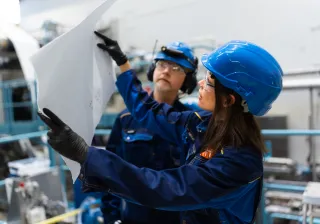In collaboration with VTT, MSC Cruises is spearheading emissions research to support decarbonisation efforts in the maritime industry. Data from measurements carried out by VTT can help to shape regulatory frameworks.
Key facts
MSC Cruises and VTT joined the EU-funded GREEN RAY research project assessing and mitigating methane slip in LNG (liquefied natural gas) engines to enable clean waterborne transport.
VTT carried out methane slip measurements during normal operations onboard the MSC World Europa cruise ship. The collaboration led to VTT conducting further emissions measurements aboard MSC Cruises’ vessels.
Supporting the decarbonisation of the maritime industry with verified data on methane emissions and by developing a unified methodology to measure emissions during the normal operation of vessels.
Headquartered in Geneva, Switzerland, MSC Cruises is the world’s third largest cruise brand with a modern fleet of 22 ships offering cruises across five continents. The company is committed to environmental stewardship with a long-term goal to achieve net zero emissions for its fleet operations by 2050. MSC Cruises is also a significant investor in next-generation environmental marine technologies, with the objective to support their accelerated development and availability industry-wide.

Towards non-fossil fuels of the future
The maritime sector is facing significant changes with emission standards becoming stricter. For example, from 2024 onwards, the updated EU Emissions Trading System (EU ETS) has required shipping companies to purchase and surrender emission allowances for each ton of reported CO2 emissions in the scope of the system. The EU ETS is a “cap and trade” system where greenhouse gas (GHG) allowances can be traded on the EU carbon market.
From 1 January 2025, the EU ETS system was complemented with the FuelEU Maritime Regulation mandating the gradual decarbonisation of shipping fuels. The aim is to contribute to EU climate goals by reducing GHG emissions intensity across the fuel lifecycle, including CO2, methane and nitrous oxide.
LNG has become a popular lower-emission fuel solution for shipping companies looking to reduce their carbon footprint. In the future, LNG type fuel can be produced from bio or synthetic sources. However, the issue of methane slip – unburned methane escaping into the atmosphere – is seen as a challenge. Methane is the second most important contributor to climate change following carbon dioxide.
VTT has extensive experience in emissions research with versatile methods and equipment for reliable monitoring.
GREEN RAY project advances maritime emissions research
Addressing this issue, the EU-funded GREEN RAY research project – coordinated by VTT – brought together a consortium of companies to develop solutions minimising methane slip from marine engines. According to VTT’s Kati Lehtoranta, Principal Scientist, Emission Control, cooperation with MSC Cruises originally began as part of this project. VTT was responsible for assessing methane emissions from existing and new LNG vessels, and carried out real time emissions measurements on one of MSC Cruises’ LNG-powered cruise ships. This led to further cooperation on other vessels.
“Conducting emission measurements onboard a ship during the normal operation of the vessel is a challenging procedure that requires specialised expertise. VTT has extensive experience in emissions research and versatile equipment for reliable monitoring. Also, I believe our ability to apply a range of different measurement methods is a benefit going forward, as it allows shipping companies to prepare for potentially changing regulatory requirements concerning monitoring in the future,” Lehtoranta says.

Shaping standards through verified data
Chief Energy Transition Officer Michele Francioni from MSC Cruises says that the main objective for joining the EU GREEN RAY project was to find out the real level of methane emissions from company vessels. This helped to set the starting point for MSC Cruises’ decarbonisation plan, lay the groundwork for discussions with engine manufacturers, as well as provide evidence for regulators towards the use of actual, more accurate emissions data rather than default values for compliance reporting.
“The default value for methane slip especially for 4-stroke engines is particularly high because it’s generally based on old generations of dual fuel engines. Our expectation was that the actual emission levels of our latest generation of dual fuel LNG engines would be much lower, and thanks to VTT, we proved this to be the case. This has led to us working together on an advocacy campaign promoting the use of actual verified emissions data also as a basis for regulatory compliance,” Francioni explains.
He says that MSC Cruises has chosen to work with VTT specifically because of the need to be able to rely on high-level technical expertise for providing consistent and robust emissions data that can be presented in public.
“We were the first in the industry to present our findings together with VTT at the Cruise Lines International Association (CLIA) European Summit in Genoa in the spring of 2024. We believe it’s important to share information openly for the benefit of the entire industry so that we can all move forward according to a shared regulatory framework based on a solid methodology,” Francioni stresses.
We’re happy to continue the journey together with VTT for the benefit of the entire industry.
Journey towards industry transformation continues
During the cooperation, VTT has provided MSC Cruises with:
Extensive technical expertise on emissions measurements in the maritime sector
A comprehensive range of advanced measurement methods
The know-how to carry out measurements during the normal operation of vessels
A product developed to make on-board measurement of emissions easier.
Besides the high level of scientific and technical ability, Francioni appreciates VTT’s deep understanding of the current issues shipping companies are facing with the evolving operating environment and regulatory framework.
“This has been a real learning experience, since before carrying out these measurements we relied only on handbooks and engine specifications for emissions data. Now that we’ve discovered the reality to be different, we’re happy to continue the journey together with VTT for the benefit of the entire industry,” Francioni says, adding that the collaboration will continue with the next batch of emissions measurements.
VTT’s Heikki Rajasalo, Solution Sales Lead, Transport Technologies, is pleased with the smooth cooperation with MSC Cruises.
“VTT continues to cooperate with several major international shipping companies, and we have a long tradition and extensive know-how in research related to the maritime industry. Emissions measurements are an important part of supporting the sector’s transition to more sustainable and cost-efficient technologies, and VTT is happy to help our customers in achieving their targets,” Rajasalo concludes.








